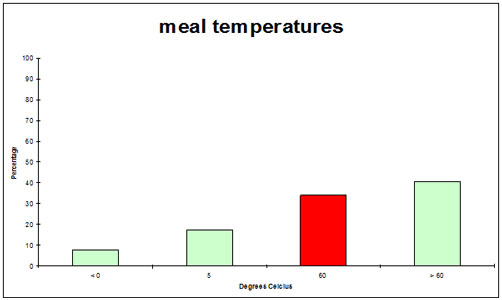Conducted by North Western Metropolitan region, Victoria
This survey was conducted as a result of 3 food borne outbreaks at aged care facilities in the North Western Metropolitan region of Victoria being attributed to Clostridium perfringens during the 1st quarter of 2010.
Samples were processed by analysts authorised under the Victorian Food Act 1984. The laboratories that processed samples are NATA accredited for the analytical methods used. Samples taken were analysed for Standard Plate Count (SPC), Escherichia coli, Clostridium perfringens and Listeria monocytogenes. Enumeration of L. monocytogenes was also included in the requested tests, to provide some background epidemiological information to the Department. The temperature of each sample was recorded at sampling, and a short questionnaire about the food safety practices of the facility was completed by the sampling officer.
In total 110 samples of hot meat meals were submitted for analysis. Meal portions included stews, meat-based soups, pasta sauces, roasts, and gravy where available. Meals were prepared either as part of a cook/chill process, a cook serve process, or produced elsewhere and delivered to the facility.
The results of these analyses were compared against the FSANZ guidelines for ready to eat foods. Most samples (99%) had low SPC counts of less than 10,000 cfu/g.C. perfringens, L. monocytogenes, and E. coli, were not detected in any of the samples. The majority of meals sampled were hot (> 60oC) or cold (oC) but 34% of meals at sampling were recorded as having a temperature between 5o and 60oC indicating a need for improvement in the temperature control of hot meals at the hot holding and service stage. In general, the food consumed in these aged care facilities is produced one-site, and usually according to a cook/serve process. The two marginal SPC samples recorded temperatures between 20-30oC at the time of sampling. These results are shown in Figure 1.
In meetings and discussion before the commencement of the survey, participating officers agreed to re-visit, re-test or follow up on adverse findings of the study or the associated questionnaire.
Hot meals generally form part of the menu at aged care facilities. As these types of meals have been associated with foodborne illness, this study was developed to get more information about the hygiene of these meals in the North and Western metropolitan region of Victoria. The meals surveyed in this work had good microbiological hygiene, despite a large proportion (34%) not being held under temperature control at the time of sampling.
It should be noted that when testing hot meals in aged care facilities, there is little waste in the food prepared. In order to be sure of obtaining samples, officers made prior arrangements with the facilities. This may have influenced the behaviours in the facilities on the day of sampling.
Figure 1: Meal temperatures

References:
Food Standards Australia New Zealand, Guidelines for the microbiological examination of ready-to-eat foods. 2001: Canberra, ACT.
The OzFoodNet Working Group, OZFOODNET quarterly report, 1 July to 30 September 2009. Communicable Diseases Intelligence, 2009. 33(4): p. 426 - 432.
Download the survey: Microbiological Surveillance of hot meat meals served in Aged Care facilities (pdf 14 kb)
